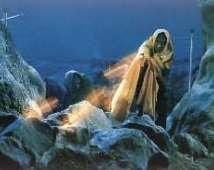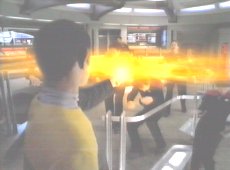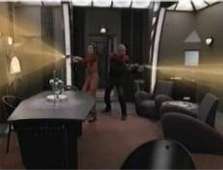Lightsabers vs. Phasers
Part of the difficulty with this page is its apparent shift on the subject matter. Is it intended to ask the question of whether or not a Jedi wielding a lightsaber would stand any chance against a phaser, or simply how powerful a lightsaber is when compared to a phaser? [Editor's note: I would say both. He is obviously playing the shell game, mixing and matching answers for two different questions in an attempt to confuse the audience into thinking he's refuted something] Anderson presents a few apparently conflicting statements, on the matter:
"We've all seen it . . . the Jedi ability to deflect blaster bolts by use of the lightsabre.
The question of whether a lightsabre could deflect the normal beam of a phaser, though an interesting question, shall not be addressed here."
For the purposes of this particular response, it will be assumed that Anderson is referring to a Jedi wielding a lightsaber due to this qualifying statement:
"It [blocking blaster fire] is, arguably, the most useful thing a lightsabre (properly wielded, of course) can do."
It will be assumed that only Jedi can "properly wield a lightsaber" in such a skillful manner as to be able to deflect blaster fire.



With that qualification, it is necessary to examine the evidence that Anderson presents. The first picture shows a phaser being fired in "The Enemy Within" [TOS]. The phaser is apparently firing very rapidly, with a very close spread between shots. The second shot is fired on a significantly divergent angle from the first and third shots, with the fourth shot appearing on a slightly different angle from the second. All four beams bear some superficial resemblance to blaster fire from Star Wars. The other two pictures shown are of Tuvok and Kira and Sisko firing their phasers in a "wide-spread" field of fire. Tuvok's weapon from "Cathexis" [VOY] is firing in a lateral spread pattern that encompasses a fairly wide field of fire. Sisko and Kira from "Way of the Warrior" [DS9] are firing in a significantly more narrow, conical field of fire.
The first picture demonstrates almost nothing, other than that "phaser sweeping" (that is, firing a phaser beam in one direction, then moving the weapon to destroy a group of enemies within the path taken by the beam or to correct faulty aim) was impractical or impossible during that particular era of Star Trek. Such a pattern of fire would be worse than useless with a weapon that maintained such an ability, because the additional "splintered" shots from the phaser would be significantly less accurate than the "phaser sweep" method of combat. This is actually a very interesting picture in regards to its implications, and is difficult to justify from a military standpoint. The angle that the second shot takes is so far different from the first and third shots so as to be nearly impossible to aim, and the fourth shot is different from that one by a narrow margin. Moreover, the angle is too great to accurately describe it as being similar to the "burst fire" setting found on many modern automatic weapons, particularly submachine guns and automatic rifles, which are designed to fire multiple rounds before there is adequate recoil to throw off a shooter's aim. Finally, one of the main advantages of having a "burst-fire" setting is firepower. The user is trying to fire several shots instead of just one. In this case, however, except at an extremely close range, at least half of the shots fired will miss the target. One would think that this would lead to decreased firepower, when compared with the firepower offered by a solid stream of energy, however this is not true. The pulse phasers used by the Defiant throughout Deep Space Nine demonstrate that the impact of a phaser is significantly more damaging than a phaser beam would be, if multiple shots are fired in succession. Thus, this is the first example of such a technique being used. Although obviously comparatively primitive compared with the weapons mounted on the Defiant a century later, the concept is already being developed. The setting on this phaser, is clearly designed to deliver the maximum damage indiscriminately to an area as quickly as possible. While far too inaccurate for reliable fire when precision is needed and likely too inaccurate to phase a Jedi (pun intended), the weapon demonstrates the considerable adaptability and multitude of functions in UFP weapons that Major Kira would comment on later. Assuming that a Jedi could block such fire using his lightsaber, such a pattern of fire would be incapable of affecting him, except at very close range, because most of the shots would miss their target. At that close range, it is likely that the lightsaber would be able to overcome the range advantage offered by phasers.
The second two pictures are more interesting, from a combat perspective. Both of them show that a phaser can be fired on a very large area at once, and even engage multiple people at once. Anderson correctly points out that the intensity of the beam will necessarily decrease as the range increases, but he fails to mention one crucial detail: both phasers were set for stun. There is no evidence anywhere of a wide-angle kill setting even in Star Trek's most modern phasers. The effects of such a stun shot on a Jedi are unknown, but Jedi can clearly adjust their vital signs without significant difficulty. In TPM, Obi-Wan and Qui-Gon were able to survive in a room filled with poisonous gas for what must have been a considerable amount of time. This would have been impossible, if Jedi lacked this ability. That Jedi control over their bodies through the Force is unquestioned, but the effects of phasers set for stun is not likely to be particularly impressive. Note that in "The Hunted" [TNG], a biochemically engineered soldier is able to resist numerous stun-blasts from phasers. It is unlikely that this would have been possible had he not been designed with the ability to do it, but it also demonstrates that stun beams are not as effective as they are sometimes proclaimed as being. The dispersed effect of a wide-angle shot would likely make it much more difficult to knock down Jedi, even if it did prevent them from fully deflecting the blast.
[Editor's note: Energy absorption is one of a Jedi's skills, as described in the official literature and demonstrated in TESB (yes, I know, some think Vader's artificial hand did the trick; didn't seem to work with Luke's artificial hand in ROTJ). With that in mind, the weakened stun blast of a wide-angle shot might not knock a Jedi out. And keep in mind that it took several shots from Jango Fett's blasters to bring down one Jedi, but just one shot to take down the gigantic charging "Reek" arena monster. If you're going to try to take down a Jedi, you'd better use something more powerful than a wide-angle stun blast, particularly since he won't let you get a second chance]